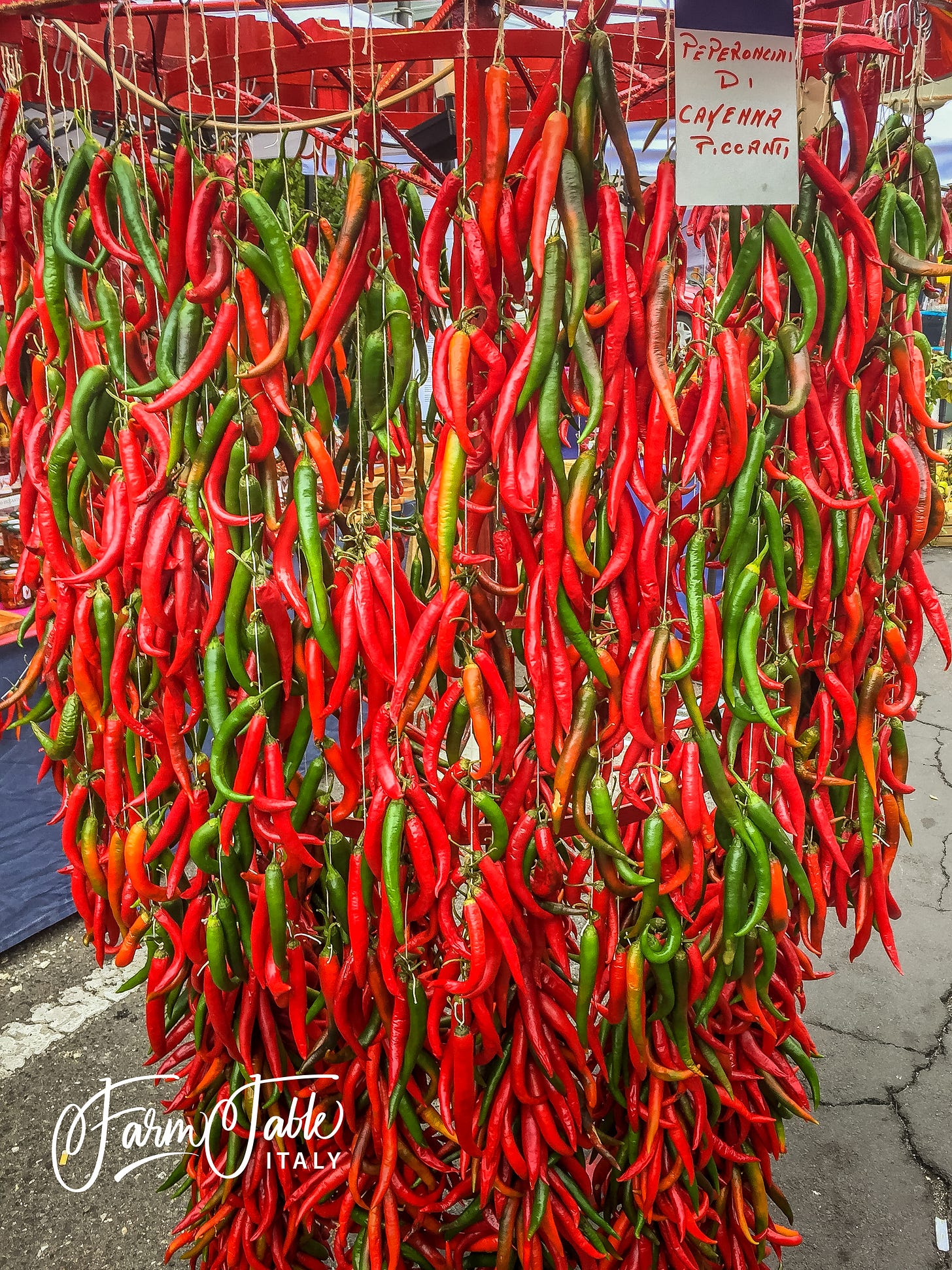Peperoni of Calabria
Purveyors of hot peppers around the province of Catanzaro have erected so many of the signs that the joke is already, well, deflated. “Viagra naturale,” they read. A basket of horn-shaped, scarlet chilis are the punch line.
Beyond their alleged aphrodisiacal qualities, the hot pepper has a mysterious hold on the South, and the regions of Calabria and Basilicata in particular. It is the mantelpiece of their mercurial cultural identity and a sort of hood ornament on the gastronomic hot rod that is Southern cuisine.
Yet, the pepper was not born here. Coming from the Americas, the Antilles, to be precise, the 'Capsicum annuum' of the Solanaceae family arrived in Europe in the late sixteenth century, thanks to the adventures of Christopher Columbus. It is said that his fleet’s doctor, Chanca, from Seville, stowed a bundle of sweet and spicy peppers in the hull of his ship and only later discovered their medical, chemical, as well as culinary virtues.
But it is safe to say -- well, in Italy at least, -- that the peperoni have found their ideal stomping grounds in the most distal extremity of Europe’s boot.
In Basilicata, in the territory of Senise, the sweet bell pepper is turned into peperone crusco – that is, crisp. Planted in February and March, it is harvested in early August when the berries are colored with an intense purple. Hanging from windows and balconies, and woven together with needle and thread from the stalk, the peppers become long necklaces that, with that bright red, seem almost there to beautify the houses, rather than to dry in the sun.
The Senise pepper, recognizable by its smaller size and sharp hook, is also called 'zafaran', as the color of the powdered dried peppers is reminiscent of saffron. It is also said that here, as in other areas of the south, the pepper and chili have taken the place of saffron (a nobler spice, but much more expensive) as it not only adds flavor but also color.
The microclimate of Senise, in the Valley of the Sinni, allowed for such a high level of specialization of the pepper that it obtained an IGT denomination in 1996. Artisanal farms produce the prized peppers in all the surrounding areas: from Chiaromonte in Valsinni, to Francavilla in Tursi, all the way to Sant'Arcangelo in Val d'Agri.
But more broadly, the hot pepper – peperoni, pepperoncini, call them what you want – are ubiquitous throughout the South. At the Locanda del Poeta agriturismo, in the province of Cosenza, in Calabria, they use it to spice up their stews and ragus of goat and black Calabrese pig, both raised on the agriturismo’s property.
If you don’t feel like wallowing with the local pigs, you can join in a regular fishing derby in their nearby lake (featuring Brown trout and European trout) or head out on a mushroom forays in the adjoining forests for porcini, Caesar’s mushrooms or pinelles. Or just unwind with a leisurely game of bocce and a glass of the local Greco Nero while smelling the aromas of the spicy lamb stew on the stove.
SPICY LAMB STEW RECIPE
Ingredients:
1 lb goat meat
½ cup of white vinegar
¼ cup virgin olive oil
2 cloves of garlic
a handful of local red hot peppers, minced
1 small can of tomato paste
4 medium tomatoes, diced
salt
Dice the goat meat and let it marinate in the vinegar and some water for a few hours. In a heavy stew pot, add the meat, oil, garlic, diced tomato, peppers, a few spoons of the tomato paste and salt. Pour in water so it covers everything.
Cook on low heat for a few hours, until meat becomes very soft.Note from David:
Eagle-eyed readers will note that I did not write this post! I’ve known John Moretti for almost ten years. I connected with John and enlisted him to help me explore our shared passion for all things farm, table, and Italy. We traveled together across Italy from Tuscany to Sicily tracking down fantastic experiences … and had a more than a few of our own. If I’m lucky, I can get him to contribute to Farm Table Italy moving forward.
Here’s a more formal bio:
They say there are two things you never want to see made: laws and sausages. As a newspaper editor and freelance correspondent in Italy for more than a decade, John Moretti is still haunted by the former image but drawn to the latter like a moth to a flame. An enthusiastic collector of farm-to-table experiences, John has been midnight fishing off the coast of Liguria for the European flying squid, porcini hunting in the wilds of Abruzzo, and has helped clean the paddocks of local pig varieties in Tuscany, to name a few of the more memorable. He is the author of “Living Abroad in Italy” and more than a dozen guidebooks on regions throughout the country.



